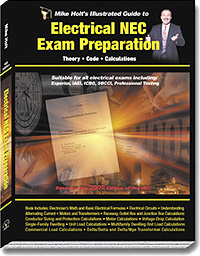Amanda,
Here is my recommendation -
Book $59.00
Printed in full color, the 2005 Exam Prep book covers Theory, Code, and Calculations in great detail. Clear colorful graphics guide you step-by-step through all the material you?ll need to pass your exam the first time. This book contains hundreds of illustrations, examples, and practice questions covering all of these subjects including 36 practice quizzes. This book is intended to be used with the 2005 National Electrical Code.
Pages: 570
Graphics: 408
Includes all the questions contained in the NEC Exam Practice Questions Textbook
Calculations Practice Questions: 788
NEC Practice Questions: 2,400
Let me list the 12 chapters -
Unit 1- Elcectrical Math and Basic Electrical Formulas
Unit 2 - Electrical Circuits
Unit 3 - Understanding Alternating Current
Unit 4 - Motors and Transformers
Unit 5 - Raceway and Box Calculations
Unit 6 - Conductor Sizing and Protection Calculations
Unit 7 - Motor Calculations
Unit 8 - Voltage Drop Calculations
Unit 9 - Dwelling unit Calcualtions
Unit 10 - Multifamily Dwelling Calculations
Unit 11 - Commercial Calculations
Unit 12 - Delta/Delta and Delta/Wye Transformers
This link has the full Table of Contents...
Here is an example of the kinds of graphics that accompany Mike's explanations in his book...on page 203
To see a couple of pages of his book to see if it's for you, consider
this link from chapter12...
If you use Mike's materials, it's a virtual guarantee that you'll pass the test(s). You can throw away hundreds of dollars with these exam groups, and "see what's on the actual test" or be secure in your knowledge after a trip though Mike holt's materials for $59. Without Mike's material's, don't know if I'd have
passed the the Washington State Electical Administrator's exam back in 93,with an 86%.
The number is 1.888.632.2633 that's 1.888.NEC.CODE.



